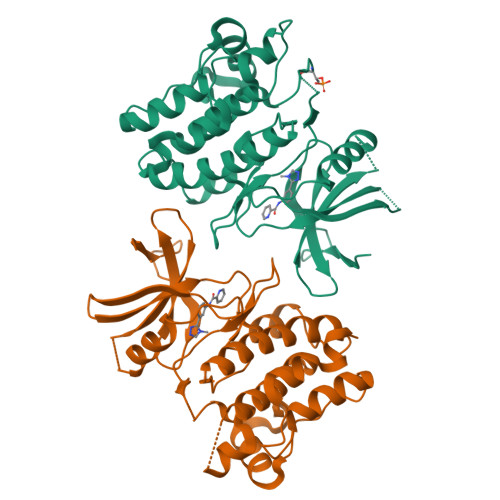ASK1 contributes to fibrosis and dysfunction in models of kidney disease.
Liles, J.T., Corkey, B.K., Notte, G.T., Budas, G.R., Lansdon, E.B., Hinojosa-Kirschenbaum, F., Badal, S.S., Lee, M., Schultz, B.E., Wise, S., Pendem, S., Graupe, M., Castonguay, L., Koch, K.A., Wong, M.H., Papalia, G.A., French, D.M., Sullivan, T., Huntzicker, E.G., Ma, F.Y., Nikolic-Paterson, D.J., Altuhaifi, T., Yang, H., Fogo, A.B., Breckenridge, D.G.(2018) J Clin Invest 128: 4485-4500
- PubMed: 30024858
- DOI: https://doi.org/10.1172/JCI99768
- Primary Citation of Related Structures:
6E2M, 6E2N, 6E2O - PubMed Abstract:
Oxidative stress is an underlying component of acute and chronic kidney disease. Apoptosis signal-regulating kinase 1 (ASK1) is a widely expressed redox-sensitive serine threonine kinase that activates p38 and c-Jun N-terminal kinase (JNK) mitogen-activated protein kinase kinases, and induces apoptotic, inflammatory, and fibrotic signaling in settings of oxidative stress. We describe the discovery and characterization of a potent and selective small-molecule inhibitor of ASK1, GS-444217, and demonstrate the therapeutic potential of ASK1 inhibition to reduce kidney injury and fibrosis. Activation of the ASK1 pathway in glomerular and tubular compartments was confirmed in renal biopsies from patients with diabetic kidney disease (DKD) and was decreased by GS-444217 in several rodent models of kidney injury and fibrosis that collectively represented the hallmarks of DKD pathology. Treatment with GS-444217 reduced progressive inflammation and fibrosis in the kidney and halted glomerular filtration rate decline. Combination of GS-444217 with enalapril, an angiotensin-converting enzyme inhibitor, led to a greater reduction in proteinuria and regression of glomerulosclerosis. These results identify ASK1 as an important target for renal disease and support the clinical development of an ASK1 inhibitor for the treatment of DKD.
Organizational Affiliation:
Gilead Sciences, Foster City, California, USA.


















